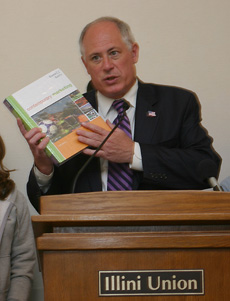Quinn targets high textbook prices

Lt. Governor Pat Quinn unveils the “Illinois College Textbook Initiative of 2005” Wednesday in the West Lounge of the Illini Student Union. Quinn said that he hopes to pass a consumer protection bill that will keep students from being gouged when it come Online Poster
August 25, 2005
Soon, textbook costs for student may decrease due to the College Textbook Initiative 2005, said Lt. Gov. Pat Quinn at a press conference Wednesday in the Illini Union.
A study released by the U.S. Government Accountability Office in July prompted Quinn’s five-part plan to prices through its finding that the cost of college textbooks has increased 186 percent over the past 20 years, double the rate of inflation.
The GAO, an independent, investigative arm of Congress, found that an average student spends between $850 to $900 on textbooks and supplies, approximately 26 percent of the cost of tuition and fees at a public, four-year college.
A third of students enrolled at the University of Illinois at Chicago, where Quinn spoke this morning, are first-generation college students who may often live paycheck to paycheck, he said.
“We want everyone with potential to be able to go to college and not be priced out by the cost of textbooks,” Quinn said.
Get The Daily Illini in your inbox!
Justin Cajindos, junior in LAS and College Democrats president, who attended the press conference, said he had spent $468 on books this semester.
“My upper-level history class required 12 books,” Cajindos said. “I’ll probably try to resell, but very often the bookstores won’t take them back.”
Quinn said he wants a bill passed by May 31, 2006 that would incorporate the reforms in the College Textbook Initiative 2005. Quinn said the bill should require stores that sell college textbooks to make “unbundled” books available for purchase, so students can buy books without accompanying CDs, workbooks and access cards.
The GAO study also found that publishers bundle supplemental materials with books to artificially drive up textbook costs.
The stores don’t always have the option of purchasing products unbundled, according to Steve Mesker, Follett’s Champaign store manager.
“It is really up to the class what they are going to use,” Masker said.
Cliff Ewert, vice president for public and campus relations for Follett’s, the nation’s largest operator of college bookstores, believes supplementary materials, such as homework and research support, study guides and multimedia CDs, can enhance a student’s performance provided they are integrated into a course by the instructor.
“More and more,” Quinn said, “textbooks are bundled with other items that may or may not be necessary.”
The profit margin on new course books averages 21 percent; on used books it averages 34 percent, according to the National Association of College Stores. The profit on sales of computer hardware is 7 percent.
Quinn believes that Illinois can become a leader in organizing students to put pressure on publishers to eliminate unfair practices.
“Just imagine if the Big Ten were the leaders,” he said. “Publishers would get the message. It is very important to have a consumer movement.”
The College Textbook Initiative Web site allows students to post comments about their textbook-purchasing experiences. The site also has a link to “Ripoff 101,” a study conducted by the State Public Interest Research Groups regarding the high cost of textbooks, which found that identical books are offered in other countries at lower prices.
Under the College Textbook Initiative, textbook sales would be provided a state sales tax exemption. Tax savings on the average student’s expenses for textbooks would be $45.
“We want citizens to be well-educated about our democracy,” Quinn said. “And that’s why sales tax is exempted on newspapers and magazines.”
Quinn also recommended textbook swapping and rental programs, which, he said, have been successful at Eastern Illinois University and Southern Illinois University.
The National Association of College Stores states on its Web site that the initial capital outlays for rental programs often prevent large savings from being realized. According to the association, faculty members must commit to their textbook choices for four to six semesters in order to see savings.
Another recommendation made by the initiative is for faculty to consider costs when assigning textbooks. Math and physics professors from 150 universities organized to get a textbook publisher to reduce the cost of their books and the number of editions it publishes, according to the “Ripoff 101” study.
Chancellor Richard Herman said the University library is affected by the rising cost of textbooks as well.
“It is very hard to provide the kind of books we need, especially in a library like ours, which has a large curatorial interest,” Herman said. “How does one absorb those costs? Eventually, they get passed on.”






